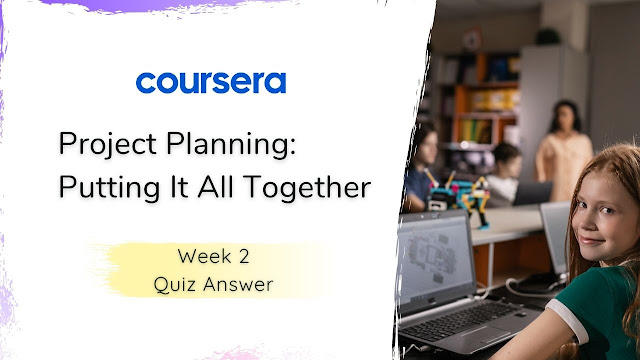When Are the Witches Planning to Meet Again and for What Purpose
Projection Planning: Putting It All Together Week 2 Quiz Answer

Project Planning: Putting It All Together
Week ii Quiz Answer
Weekly Challenge 2
Question 1)
When creating a project plan, you include important points within the schedule that indicate progress. Which project plan component does this represent?
- Tasks
- Milestones
- Time
- Relevant documentation
Question 2)
What tools can a project manager use to account for issues that may cause a projection delay? Select all that utilize.
- Gantt chart
- Sub-tasks
- Chore buffer
- Project buffer
Question iii)
Fill in the blank: To determine the _____ of a projection, list the milestones you must attain in order to see the project goal on schedule.
- bladder time
- capacity planning details
- critical path
- dependencies
Question 4)
Which examples beneath demonstrate a projection manager request an open-ended question? Select all that apply.
- What are the bug I need to be enlightened of regarding the current project timeline?
- What are the steps in your customer feedback review process and what factors practice you include in your report of this review?
- Will you lot be able to have the transportation program for the launch of the new truck series to dealerships fix by side by side week?
- Can you have this web pattern proposal completed and back to me past close of business Fri?
Question 5)
Tools similar Gantt charts and Kanban boards assistance benefit team members in what 3 means?
- They tin translate project contracts like the statement of piece of work (SOW) into number and dollar amounts.
- They can illustrate when they need to complete their private tasks.
- They provide clear context about piece of work project details.
- They can demonstrate how their individual tasks connect to other tasks in the project.
Question 6)
As a project managing director, you lot're the principal supporter of your projection plan. You explain to teammates why it benefits them to stay on top of the program. You hope that this persuades the squad to support the programme and update it regularly. What projection plan best practice does this represent?
- Giving yourself time to program
- Staying curious
- Recognizing and planning for the inevitable
- Championing your programme
Question vii)
Which of the following strategies could help a team meet a project deadline? Select all that apply.
- Rush through task planning
- Increase the team size
- Streamline tasks
- Eliminate unnecessary tasks
Question 8)
Fill in the blank: The _____ is the trend to underestimate the amount of time information technology volition have to complete a task.
- feedback fallacy
- planning fallacy
- anchoring bias
- confirmation bias
Question 9)
Imagine y'all're a projection manager creating a critical path. Your stakeholders request the earliest and latest outset dates for each chore. What is a strategy to make this fourth dimension estimate?
- Create a listing of dependencies.
- Use the frontwards pass or backward pass method.
- Review the projection goals.
- Develop a RACI chart.
Question ten)
Fill in the bare: A Kanban board utilizes cards placed in columns to _____.
- set up the timeline
- guess the budget
- manage tasks
- organize documents
-----------------------------------------------------------------------------------------
Extra Questions
Question 1)
Fill in the blank: Fourth dimension estimation predicts the total amount of time required to complete a chore, while the actual fourth dimension it takes to consummate a task _____. Question iii) A projection manager is leading an initiative that includes changing an organization's logo and slogan. What mandatory tasks should be part of the critical path? Select all that apply. Question 4) Equally a project manager, the project is your number one priority. Still, you accept team members with competing priorities from other projects. You want to influence them to make your project their priority. To do this, yous bridge the high-level goals of the project and the day-to-24-hour interval perspective of the team. You collaborate to notice an issue that works for everyone. What interpersonal skill did you mainly utilize in this scenario? Question 5) Which of the post-obit should you include in a project plan that are essential for projection success? Select all that apply. Question vi) Which of the post-obit strategies follow project programme all-time practices? Select all that apply. Question 7) Which of the following is a best practice when estimating the project timeline? Select all that apply. Question viii) What is a strategy to overcome the planning fallacy? Question 9) Which of the following are some steps to create a critical path? Select all that apply. Question x) Which of the following is a visual tool a project manager can use to manage tasks and workflows?
Question 11) What are the benefits of a Gantt nautical chart? Select all that apply. Question 12) When creating a disquisitional path, what does a network diagram assist visualize? Select all that apply. Question xiii) Which of the following are relevant project documents y'all should link to in your project plan? Select all that apply. Question 14) Make full in the blank: The principal difference betwixt attempt interpretation and time estimation is that time estimation includes _____. Question xv) What is capacity in project management? Question xvi) What project management tool typically organizes tasks into columns with labels such as to practice, in progress, and done?
Source: https://niyander.blogspot.com/2021/10/Project%20Planning%20Putting%20It%20All%20Together%20Week%202%20Quiz%20Answer.html
0 Response to "When Are the Witches Planning to Meet Again and for What Purpose"
Post a Comment